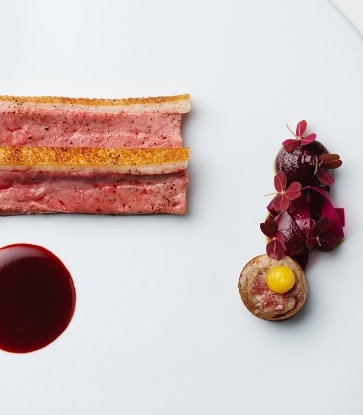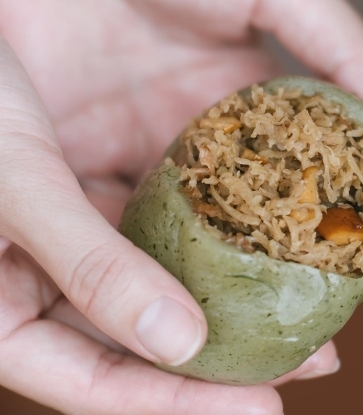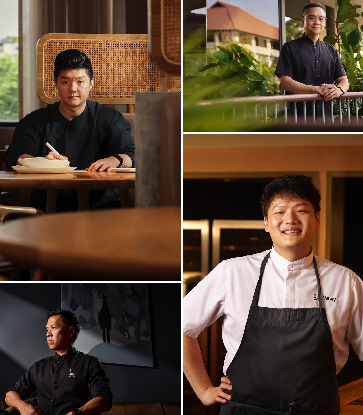A shared tradition in the early days amongst most Taiwanese households was to serve a hearty plate of fried rice vermicelli whenever there were surprise visits by family and friends. Immensely popular and best eaten while piping hot, this classic home cooked dish gave rise to the Taiwanese expression of “yelling ‘hot!’ while others eat their vermicelli”, a phrase used to criticise someone for being nosey. It’s a dish that’s also enjoyed even after it cools, which is why it is often the food of choice to be served to supporters during election rallies.
A serving can cost anywhere from NTD30 (S$1.20) up to NTD600 (S$29). The difference in price stems from both the quality of the ingredients and the skills of the chef. At MICHELIN-starred Mountain and Sea House in Taipei, only the best ingredients make the cut. Instead of the usual bean sprouts and minced pork gravy, the restaurant’s elevated version makes use of only top-notch rice vermicelli (80% Indica rice), dried scallop stock and dried octopus from the Penghu county.

According to the restaurant’s executive chef Tsai Rui-Lang, a good plate of stir-fried rice vermicelli has to exhibit lightness, moistness and long strands of noodles.
First, being the soul of the dish, the quality of the vermicelli used is of paramount importance. At Mountain and Sea House, only the vermicelli of the highest grade and with the highest rice content is selected, to give a permeating aroma of rice without a cloying finish. Each strand of vermicelli should also be of substantial length, which adds to the aesthetic value of the whole dish.
In the process of cooking, Tsai advises against using a spatula as the sharp edge might break the delicate strands of rice vermicelli. A pair of long chopsticks is the utensil of choice but one should refrain from mixing too excessively as vermicelli with high rice content tends to be more fragile, thus requiring extra attention while it is being cooked.
The ratio of the gravy and rice vermicelli is also key, says Tsai. A good plate of stir-fried rice vermicelli has to be light, but many cooks have the habit of putting the lid on the wok once the gravy has been added, causing excessive moisture to be absorbed by the noodles. This results in a starchy dish which not only taste less than stellar, but looks unrefined as well.

The Right Ratio
Too much gravy is detrimental to the dish. If the excess gravy is not absorbed, not only will the presentation of the dishes be adversely affected, but also its taste. “Vermicelli has to be stir-fried, instead of steamed. The cabbage should be cooked at medium or low flame. Many people add too much water trying to prevent the vegetables from overcooking, but this will suppress its flavours,” he explains.
Although Tsai emphasises the need for the vermicelli to fully absorb the gravy, he is not referring to the dry-frying technique to create the smoky taste of wok hei in other stir-fried dishes like beef rice noodles or char kway teow. It is still crucial to simmer the vermicelli for a short while after adding the gravy.
Try your hand at this recipe by Mountain and Sea House.
Classic Fried Vermicelli
(Serves 3-4)
Ingredients:
250g soaked rice vermicelli
10g dried octopus, diced
6g dried shrimps, soaked
1 piece of Shiitake mushroom, chopped
10-15g black pork, chopped
5g onion, chopped
3-5g shallots
100g cabbage, shredded
10g carrots, shredded
10g celery, shredded
5g leeks, sliced
100g scallop stock
Seasonings:
Light soy sauce, thick soy sauce, pepper, sugar
Condiments:
Shallot oil, black vinegar
Method:
1. In a wok, sautée the dried octopus and dried shrimp with oil until the flavour is released and set aside.
2. Stir-fry the chopped onion, shiitake mushroom and pork briefly before adding the sautéed octopus and shrimps from step one. Stir-fry together well.
3. Next, add the cabbage, carrots, celery and leeks to the wok and stir-fry well.
4. Season to taste with the soy sauce, thick soy sauce, pepper and sugar and continue to stir-fry.
5. Add the scallop stock.
6. Add the soaked rice vermicelli and mix well with a pair of long chopsticks, until the stock has been absorbed fully.
7. Place the lid on the wok and continue to let cook for 3 to 5 minutes.
8. Drizzle with some shallot oil and vinegar to taste before removing from heat to serve.
This article was written by Chen Ching-Yi and translated by Tang Jie. Click here to read the original story.


















